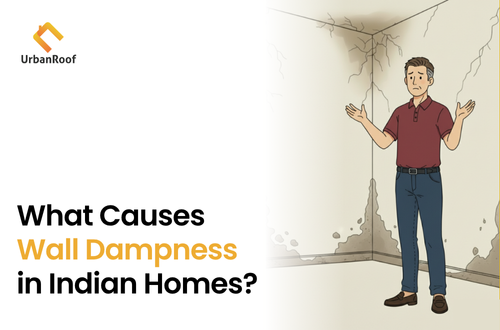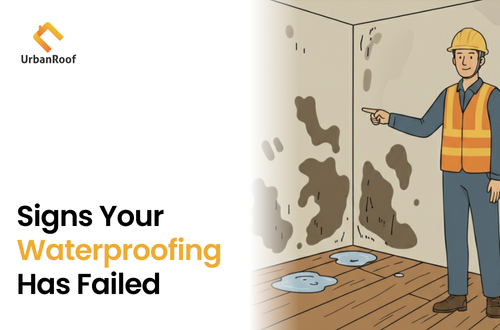What Causes Wall Dampness in Indian Homes?
Understanding the Hidden Enemy Behind Wall Damage
Wall dampness is one of the most common and frustrating problems faced by Indian homeowners. What starts as a small patch of moisture can quickly turn into peeling paint, foul odours, mould growth, and even structural damage.
While most people treat it with a quick coat of paint, the truth is — wall dampness is a symptom, not the disease. Understanding the real causes is the first step toward solving it permanently.
At UrbanRoof, we’ve inspected thousands of homes across India and identified the key reasons why dampness appears and how to prevent it effectively.
1. Poor or Damaged Waterproofing
The most common cause of wall dampness is inadequate waterproofing — especially on terraces, bathrooms, and external walls.
When the waterproofing layer fails, rainwater or groundwater seeps into walls, travelling through plaster and reaching interior surfaces. Over time, this causes paint to bubble, crack, or peel.
UrbanRoof Insight: Regular roof and wall waterproofing checks every 2–3 years can prevent 80% of dampness issues.
2. Leakage from Plumbing Lines
Hidden leaks in internal plumbing — such as bathroom pipelines, drainage outlets, or kitchen sinks — can cause localized dampness on adjacent walls.
Since these leaks are often slow, the signs show up gradually: faint stains, musty smells, or slightly wet corners. If ignored, they can lead to fungus and wall efflorescence (white powdery deposits).
Tip: Watch for damp patches that appear even in dry weather — these often signal internal plumbing leaks.
3. Cracks in Walls and Roofs
Cracks act as open doors for water entry. Whether due to structural movement, poor construction joints, or temperature changes, these cracks allow rainwater to enter the masonry.
Even hairline cracks can cause deep dampness over time. The water seeps in during rains and stays trapped, keeping walls moist for weeks.
UrbanRoof Solution: Sealing minor cracks with elastomeric coatings or crack fillers before monsoon can prevent moisture intrusion.
4. Groundwater Seepage and Rising Damp
In many older buildings or ground-floor homes, moisture rises upward from the soil through the wall base — a phenomenon called capillary action.
This “rising damp” usually shows up as dark patches or salt deposits on lower walls. It’s common in areas with poor drainage, lack of a damp-proof course (DPC), or continuous exposure to groundwater.
To stop it, the wall must be properly treated with a barrier waterproofing system to block upward moisture movement.
5. Poor Ventilation and High Humidity
In tropical regions of India, humidity itself can be a major cause of wall dampness. Poorly ventilated rooms trap moisture, especially in kitchens, bathrooms, and basements.
When warm indoor air meets cooler wall surfaces, condensation forms — making walls appear damp even without external leakage.
Simple Fix: Increase ventilation, use exhaust fans, and apply anti-condensation coatings in moisture-prone rooms.
6. Faulty Exterior Design and Drainage
Improper exterior slope, clogged roof drains, or water accumulation near walls can all contribute to dampness. When water stays in contact with the building envelope for long periods, it eventually penetrates the structure.
UrbanRoof Tip: Ensure your terrace has proper slope and drainage outlets to prevent standing water after rains.
7. Poor Quality Construction Materials
Sometimes, the issue starts during construction itself. Using low-grade bricks, porous plaster, or non-water-resistant paints can make walls more prone to dampness.
Proper curing and quality waterproof materials during construction ensure long-term protection against moisture.
How UrbanRoof Helps Fix Wall Dampness
UrbanRoof’s dampness diagnosis system uses moisture meters, infrared scanning, and leak trace technology to find the root cause — not just the visible stains.
Once the cause is confirmed, we provide a custom waterproofing solution, including:
- Crack sealing and surface protection
- Internal and external wall coatings
- Terrace and foundation waterproofing
- Post-repair moisture testing
Our goal: to make your walls dry, durable, and damage-free for years to come.
Final Thoughts
Wall dampness may look like a minor cosmetic issue, but it signals deeper structural or waterproofing failures. Ignoring it only worsens the damage and increases long-term costs.
By identifying the source early and choosing the right waterproofing partner, you can ensure your walls stay strong, beautiful, and healthy.
UrbanRoof’s experts specialize in detecting and fixing all types of wall dampness — from small leaks to large seepage issues — with guaranteed results.




